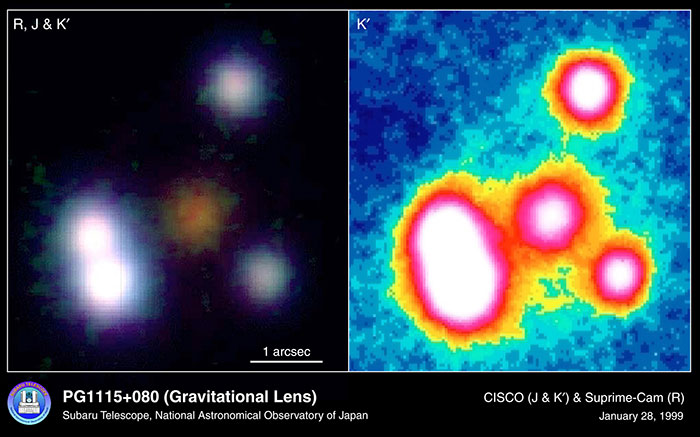Subaru Telescope Capability Confirmation Image
Astrophotography・

| Object | PG1115+080 |
|---|---|
| Telescope | The Subaru Telescope |
| Instrument | CISCO(J&K’) & Suprime-Cam(R) |
| Wavelengths | Infrared, Visible |
| Date | January 12 (K band), 13 (R band), 14 (J band) 1999 |
| Copyright | National Astronomical Observatory of Japan |
The Subaru Telescope had its first light on Christmas 1998. Time has gone quickly; it is already more than 15 years since then. This image is a gravitationally lensed object observed in visible and infrared light 3 weeks after first light. It exemplifies the early successes of the Subaru Telescope in many ways. The Subaru Telescope’s ability to achieve the 0.33 arcsecond resolution demonstrated in this image indicates the superior quality of the telescope, enclosure and Mauna Kea’s weather conditions. That this image was taken only 3 weeks after first light inspired renewed awe in Japan’s high level of technological capabilities.
The Fervor Immediately Following the Subaru Telescope’s First Light
At the time of the Subaru Telescope’s first light, I was staying in Hawai`i for the final adjustments to the observational instruments. I went to observe the state (chaos?) of the summit telescope control room. Anyway, even though it was a large telescope, many things like the primary mirror actuators were controlled in real time. Standing nearby, I could see how difficult the adjustments were. I spent New Year’s in Japan, but then returned immediately to Hawai`i and attached CISCO, the near infrared camera produced by Kyoto University, to the telescope for telescope capability confirmation observations. This time, we chose a gravitationally lensed object which is astronomically important while at the same time capable of demonstrating the telescope’s performance. Through observations of this celestial object, we confirmed that determining the resolving power through multiple short exposure images taken using the detector unit’s high-speed read-out mode is satisfactory compared to atmospheric instabilities and the telescope’s inherent capabilities. The central foreground galaxy acting as a lens increases the brightness of the background quasar by roughly a factor of 10 and enlarges its image. As appropriate for the results from this “natural telescope,” we obtained new information about the central vicinity of the quasar and the host galaxy. These results became one of the Subaru Telescope’s first light reports.
Author: Fumihide Iwamuro (Kyoto University)